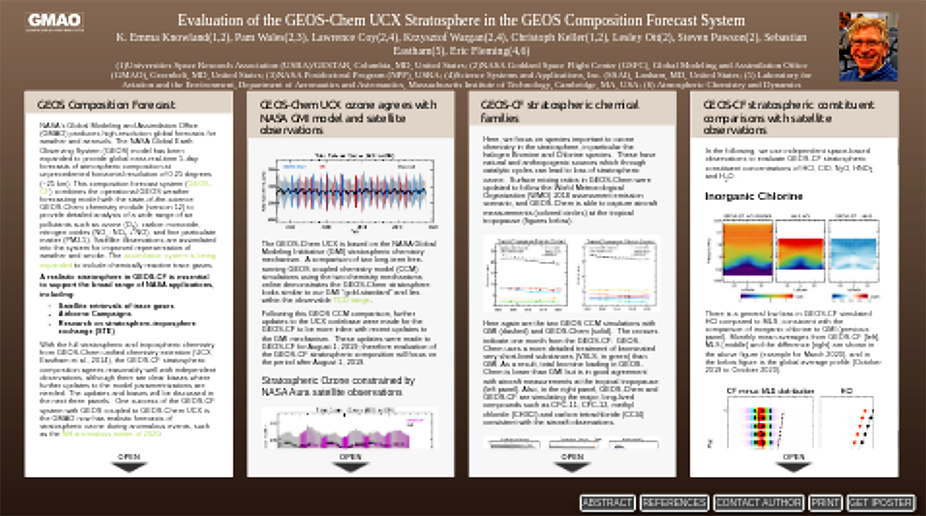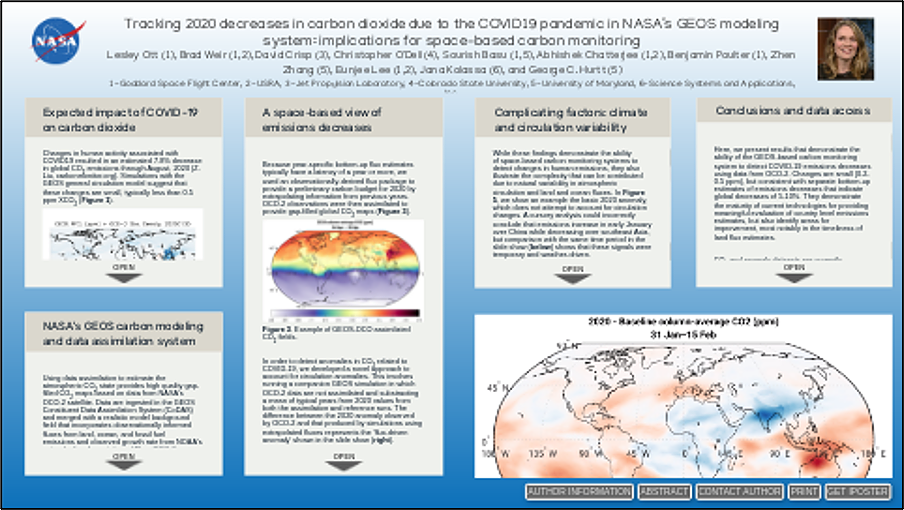GMAO Attends AGU 2020—Virtually
01.20.2021 
NASA's Global Modeling and Assimilation Office (GMAO) had a strong presence at this year’s American Geophysical Union (AGU) Fall Meeting, which was held virtually from December 1 to 17, 2020. GMAO scientists presented talks and posters on topics ranging from drought to how carbon dioxide decreased due during the COVID-19 pandemic.
Poster presentations and talks were handled quite differently at AGU 2020. Posters were not the classic printed paper attached to a display board. For this virtual conference, the posters were online and dynamic, allowing for more information in the form of text, images, movies and audio. They were also available for about 17 hours per day to allow the global community to view them.
Also new for AGU 2020 were the eLightning presentations, a combination of a poster session with a three-minute talk. This presentation allowed presenters to talk briefly about their posters then schedule time for a Zoom meeting to discuss in more depth.
Talks were similar to what one might normally experience at AGU in person. These virtual talks were limited to up to five minutes in length, in addition to a 15-minute pre-recorded presentation.

GMAO Prerecorded Presentations:
- Arlindo da Silva: “Lidar-Polarimeter Retrieval OSSEs using a Nature Run in Support of NASA's Aerosols, Clouds, Convection and Precipitation (ACCP) Study”
- Young-Kwon Lim: “MJO Prediction Skill and Associated Dynamics as Revealed by NASA GEOS Subseasonal Forecasts”
- Erica McGrath-Spangler: “Impact of Hyperspectral Infrared Radiance Assimilation in Cloudy Regions: A Study of the 2017 Atlantic Tropical Cyclone Season with the NASA GEOS”
- Lesley Ott: “How will future satellite missions inform our understanding of the processes controlling atmospheric carbon?” and “Toward integrated seasonal predictions of carbon flux: lessons learned from NASA’s subseasonal-to-seasonal predictions”
- Siegfried Schubert: “The Fall 2019 Southeast U. S. Flash Drought: An Extreme Event Driven by an Extreme Positive Indian Ocean Dipole”
- Pamela Wales: “Satellite-Based Emission Estimates of Tropospheric Bromine During Arctic Spring and Impact on Surface Ozone and Background Air Quality in the GEOS-Chem Global Model”
Posters and eLightning Presentations:
- Nathan Arnold – “Impact of Resolution and Parameterized Convection on the Diurnal Cycle of Precipitation in a Global Nonhydrostatic Model” and “Development of a unified representation of boundary layer clouds and turbulence in the NASA GEOS AGCM”
- Nathan Arnold - "Development of a unified representation of boundary layer clouds and turbulence in the NASA GEOS AGCM"
- Nikolay Balashov – “Short Term Effects of 2019 Early Summer Floods on Atmospheric CO2 in the Midwestern and Southern Regions of the United States as Seen from the NASA GEOS Model”
- Mohar Chattopadhyay – “Assimilation of Historical AVHRR Data in a Reanalysis Context”
- Larry Coy – “Forecasting the 2019/20 NH winter low column ozone with the NASA GEOS model” and “The Antarctic stratospheric warming and its impacts in 2019”
- Amin Dezfuli – “A strong atmospheric river responsible for the 2019 record floods in the Middle East”
- Eric Hackert – “Effect of rain-adjusted satellite sea surface salinity on ENSO Predictions from the GMAO S2S Forecast System”
- Emma Knowland - "Evaluation of the GEOS-Chem UCX Stratosphere in the GEOS Composition Forecast System"
- Emma Knowland – “Near real-time air quality forecasts using the NASA GEOS model” and “Evaluation of the GEOS-Chem UCX Stratosphere in the GEOS Composition Forecast System”
- Randy Koster – “Imprints of Soil Moisture Memory on Predictability and T2M Bias in SubX Subseasonal Forecasts”
- Eunjee Lee – “Isolating the impacts of soil moisture initialization on land carbon fluxes at the sub-seasonal to seasonal scale”
- Carl Malings – “Combining atmospheric chemistry model outputs, satellite retrievals, and ground monitoring data to improve city-scale air quality estimation and near-term forecasting”
- Will McCarty – “The Use of Spire Radio Occultation Measurements in the GEOS Atmospheric Data Assimilation System”
- Isaac Moradi – “The OSSE Framework at the NASA Global Modeling and Assimilation Office (GMAO)”
- Kris Wargan – “Overview of the SPARC Reanalysis Intercomparison Project (S-RIP) during 2013-2020”
Please visit https://gmao.gsfc.nasa.gov/pubs/index.php?sel=posters&yr=2020 to view PDF versions of their AGU posters.



